Epi Profile Section 2 – Texans Living with HIV in 2018
Texans Living with Diagnosed HIV Infections
This section describes Texans living with diagnosed HIV infections, which is also called prevalence.
As of the end of 2018, over 94,000 Texans were living with a diagnosed HIV infection. The number of people living with HIV (PLWH) increased by 16% over the past 5 years, but this is not due to increases in the annual number of Texans getting diagnosed. The number of Texans diagnosed each year has been flat over the last decade at about 4,500 (Figure 1).
The number of PLWH increased because effective treatment extends the lifespan of PLWH. In fact, PLWH who are diagnosed early and begin treatment right away have lifespans almost as long as people who are not living with HIV. [5] Longer lives means that deaths in PLWH are low (about 1,400 a year). Since the annual number of deaths is lower than the number of people diagnosed each year, the number of people living with HIV rises.
Please note that the number of people living with HIV does not include an estimated 16,000 Texans who are living with undiagnosed HIV infections.
Figure 1: Texas PLWH, Texans with new HIV diagnoses, and deaths among Texas PLWH, 2009-2018 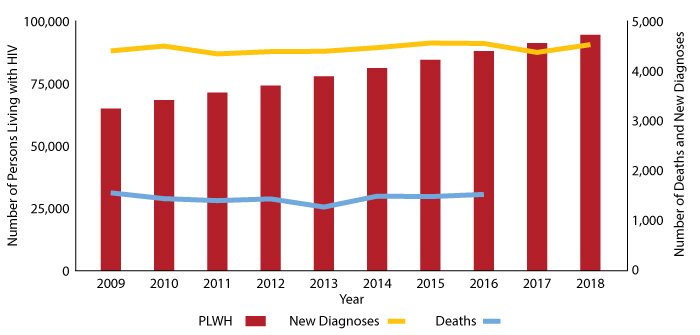
Source: Texas eHARS, 2018
Data for Figure 1
The profile of Texans living with HIV in 2018 shows:
- Almost four out of five PLWH were male; [6]
- About 1% identified as transgender women;
- About 7 out of 10 of the PLWH were Black or Hispanic;
- About half of the PLWH were 45 or older;
- About three out of five were gay and bisexual men or other men who have sex with men (MSM);
- About half of all Texas PLWH lived in the Dallas and Houston areas; and that
- Black Texans and MSM were disproportionately affected by HIV.
Table 4 at the end of this section gives a detailed look at the profile of PLWH.
Texas PLWH by Sex at Birth and Race/Ethnicity
About 70% of the PLWH in 2018 were Black or Hispanic, but the profile differed by sex. Almost three out of five female PLWH were Black, but males showed a more even distribution across groups (Figure 2 and Table 1).
Figure 2: Texans living with HIV by race/ethnicity and sex at birth, 2018 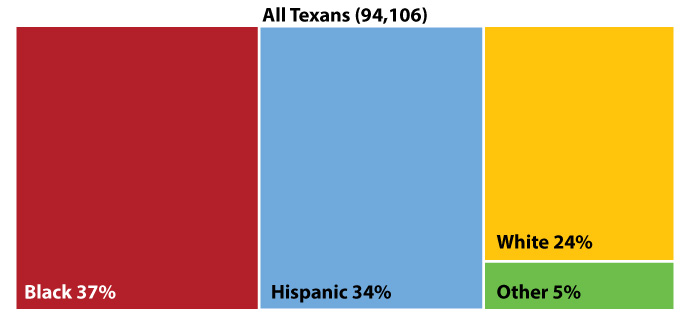
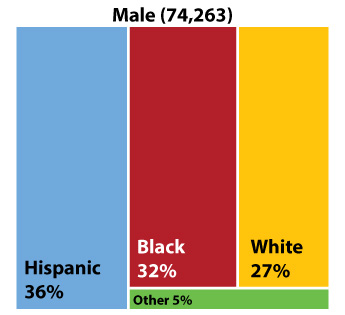
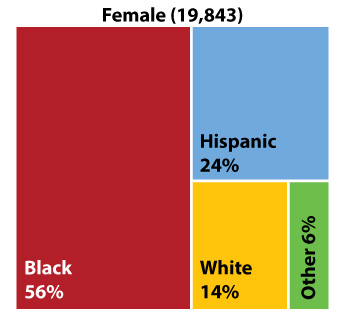
Data for Figure 2
Table 1: Numbers and rates per 100,000 of Texans living with HIV in 2018 by sex at birth and selected race/ethnicities
| Demographics |
Number of |
% of |
Rate for |
Number of |
% of Females |
Rate for |
|---|---|---|---|---|---|---|
|
Race/Ethnicity |
|
|
|
|
|
|
|
White |
20,208 |
27% |
342.2 |
2,687 |
14% |
45.6 |
|
Black |
23,447 |
32% |
1,408.8 |
11,201 |
56% |
630.6 |
|
Hispanic |
26,826 |
36% |
468.7 |
4,817 |
24% |
80.8 |
Source: Texas eHARS, 2018
Texas PLWH by Mode of Transmission Groups
Mode of transmission means the most likely way someone acquired HIV. We group people with the same mode of transmission together to follow trends and gauge the impact of HIV. The most common mode of transmission groups in Texas are MSM, people who inject drugs (PWID), MSM who inject drugs (MSM/PWID), and men and women who acquired HIV through heterosexual sex.
In Texas, over 6 out of 10 PLWH were MSM, but men and women had different profiles. Close to four out of five men and four out of five women acquired HIV through sex with a man (Figure 3 and Table 4).
Figure 3: Transmission group profiles of Texas PLWH by sex at birth, 2018

PLWH with other mode of transmission categories made up 1% of male PLWH and 3% of female PLWH.
Source: Texas eHARS, 2018
Data for figure 3
Texans Living with HIV by Geography
More than half of PLWH lived in the Dallas and Houston areas in 2018. An additional 21% live in the Austin, Fort Worth, and San Antonio areas.
Table 2: Texas PLWH by current residence, 2018
| Area |
Number |
% |
|---|---|---|
|
Austin Transitional Grant Area (TGA) [7] |
6,445 |
7% |
|
Dallas Eligible Metropolitan Area (EMA) |
23,036 |
25% |
|
Fort Worth TGA |
6,290 |
7% |
|
Houston EMA |
29,078 |
31% |
|
San Antonio TGA |
6,893 |
7% |
|
All other areas |
18,241 |
19% |
|
Texas Department of Criminal Justice facilities/ |
4,123 |
4% |
|
Total |
94,106 |
100% |
Source: Texas eHARS, 2018
Prevalence Rates
Rates allow direct comparison of the impact of HIV on groups of different size and are used to show health disparities. The HIV prevalence rate is the number of people with HIV in a group for every 100,000 members of that group.
Figure 4 shows that Black Texans had rates that were 3 to 13 times higher than those for White and Hispanic Texans.
Figure 4: Prevalence rates by sex at birth and selected race/ethnicities, Texas 2018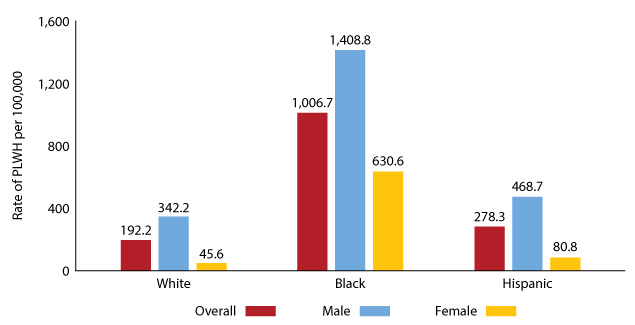
Data for Figure 4
MSM were also disproportionately affected; White, Black, and Hispanic MSM had rates that were 15 to 35 times higher than the overall rates for these race/ethnicity groups (Figure 5).
Figure 5: Prevalence rates per 100,000 in MSM, Texas 2018
Data for Figure 5
The other way of looking at burden of disease is ‘1 in’ statements. For Texas overall in 2018, 1 in 305 Texans was living with a diagnosed HIV infection. DSHS estimates that about 1 in 6 Black MSM were living with diagnosed HIV in 2018, as were 1 in 10 Hispanic MSM, and 1 in 15 White MSM.
Table 3: 'One in' statements for groups of Texans living with HIV in 2018
| Demographics |
1 in |
Demographics |
1 in |
|---|---|---|---|
|
All Texans |
305 |
White Texans |
359 |
|
Men |
192 |
White men |
292 |
|
Women |
728 |
White women |
2,193 |
|
MSM |
11 |
Black Texans |
99 |
|
White MSM |
15 |
Black men |
71 |
|
Black MSM |
6 |
Black women |
159 |
|
Hispanic MSM |
10 |
Hispanic Texans |
359 |
|
|
|
Hispanic men |
213 |
|
|
|
Hispanic women |
1,238 |
Source: Texas eHARS, 2018
Table 4: Texans living with HIV by select characteristics, 2018
| Demographics |
Number |
% |
Rate per |
|---|---|---|---|
|
Sex at birth |
|
|
|
|
Male |
74,263 |
79% |
520.7 |
|
Female |
19,843 |
21% |
137.4 |
|
Current Gender Identity |
|
|
|
|
Transgender Women |
683 |
1% |
|
|
Transgender Men |
17 |
<1% |
|
|
Race/Ethnicity |
|
|
|
|
White |
22,895 |
24% |
192.2 |
|
Black |
34,648 |
37% |
1,006.7 |
|
Hispanic |
31,643 |
34% |
278.3 |
|
Age group (years) |
|||
|
0-14 |
206 |
<1% |
3.3 |
|
15-24 |
3,747 |
4% |
93.0 |
|
25-34 |
19,039 |
20% |
449.4 |
|
35-44 |
21,321 |
23% |
549.3 |
|
45-54 |
25,109 |
27% |
706.7 |
|
55-64 |
18,650 |
20% |
576.6 |
|
65+ |
6,034 |
6% |
167.5 |
|
Mode of transmission group |
|||
|
MSM |
57,602 |
61% |
8,818.8 |
|
PWID |
8,390 |
9% |
|
|
MSM/PWID |
5,263 |
6% |
|
|
People with heterosexual contact |
21,853 |
23% |
|
|
All other modes |
998 |
1% |
|
|
Total |
94,106 |
|
327.9 |
Source: Texas eHARS, 2018 rates cannot be calculated for most transmission groups due to a lack of established methods of estimating the denominator.
Note 5. cdc.gov/vitalsigns/hiv-aids-medical-care/infographic.html
Note 6. Based on sex at birth
Note 7. The EMA and TGA designations come from the Ryan White HIV/AIDS Program. It is a common geographic unit used in HIV analysis.
Texas HIV Epidemiologic Profile
